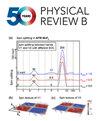磁绝缘体隧道结中的Rashba自旋轨道效应
IF 3.7
2区 物理与天体物理
Q1 Physics and Astronomy
引用次数: 0
摘要
在Keldysh形式论和紧密结合模型的框架下,我们研究了单势垒隧道结中的自旋轨道现象,如异常和自旋霍尔效应、隧道各向异性磁电阻和rashba诱导的自旋轨道转矩。我们重点研究了两种结构:一种是铁磁金属[正常金属(NM)/绝缘体(I)/铁磁金属(FM)],另一种是铁磁绝缘体[NM/铁磁绝缘体(FI)/NM],两者都包含不对称界面Rashba自旋轨道耦合。利用解析方法和数值模拟,导出了这些自旋轨道现象的表达式。我们发现,虽然在两种构型中异常霍尔效应和自旋轨道转矩的表现相似,但当使用FI时,隧道各向异性磁电阻和自旋霍尔效应的角依赖性显着提高了近一个数量级。即使在适度的交换分裂中,这种增强仍然存在,这表明Eu硫族化合物和尖晶石氧化物等fi有望用于高效自旋电子应用。此外,我们观察到在NM/I/FM结中,当系统从半金属转移到低带填充状态时,这些效应出现了明显的逆转,而在NM/FI/NM中,由于屏障的自旋过滤效应,没有发生这种逆转。2025年由美国物理学会出版本文章由计算机程序翻译,如有差异,请以英文原文为准。
Rashba spin-orbit effects in tunnel junctions with magnetic insulators
In the framework of the Keldysh formalism and the tight-binding model, we investigate spin-orbit phenomena such as the anomalous and spin Hall effects, tunneling anisotropic magnetoresistance, and Rashba-induced spin-orbit torque in single-barrier tunnel junctions. We focus on two configurations: one with a ferromagnetic metal [normal metal (NM)/insulator (I)/ferromagnetic metal (FM)] and the other with a ferromagnetic insulator [NM/ferromagnetic insulator (FI)/NM], both incorporating an asymmetric interfacial Rashba spin-orbit coupling. Using analytical methods and numerical simulations, we derive expressions for these spin-orbit phenomena. We find that while the anomalous Hall effect and spin-orbit torque behave similarly in both configurations, tunneling anisotropic magnetoresistance and the angular dependence of spin Hall effect are significantly enhanced by nearly an order of magnitude when a FI is used. This enhancement remains even for modest exchange splittings, suggesting that FIs such as Eu chalcogenides and spinel oxides are promising for high-efficiency spintronic applications. Additionally, we observe a sign reversal of these effects in NM/I/FM junctions as the system shifts from half-metallic to low-band-filling regimes, while no such reversal occurs in NM/FI/NM due to the spin-filtering effect of the barrier. Published by the American Physical Society 2025
求助全文
通过发布文献求助,成功后即可免费获取论文全文。
去求助
来源期刊

Physical Review B
物理-物理:凝聚态物理
CiteScore
6.70
自引率
32.40%
发文量
0
审稿时长
3.0 months
期刊介绍:
Physical Review B (PRB) is the world’s largest dedicated physics journal, publishing approximately 100 new, high-quality papers each week. The most highly cited journal in condensed matter physics, PRB provides outstanding depth and breadth of coverage, combined with unrivaled context and background for ongoing research by scientists worldwide.
PRB covers the full range of condensed matter, materials physics, and related subfields, including:
-Structure and phase transitions
-Ferroelectrics and multiferroics
-Disordered systems and alloys
-Magnetism
-Superconductivity
-Electronic structure, photonics, and metamaterials
-Semiconductors and mesoscopic systems
-Surfaces, nanoscience, and two-dimensional materials
-Topological states of matter
 求助内容:
求助内容: 应助结果提醒方式:
应助结果提醒方式:


